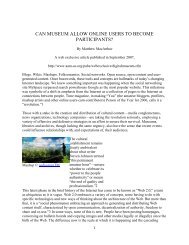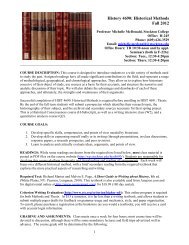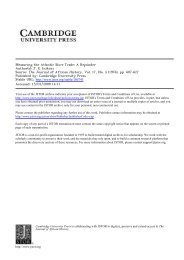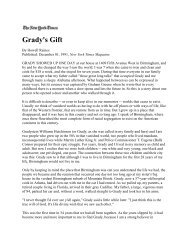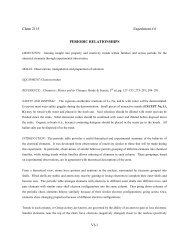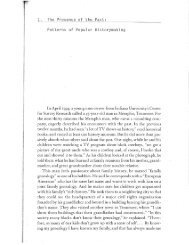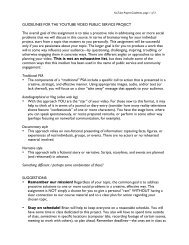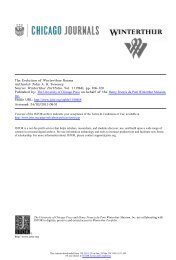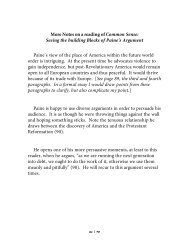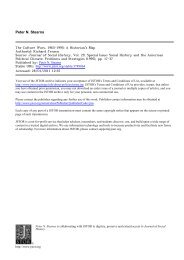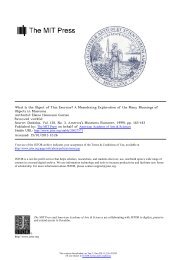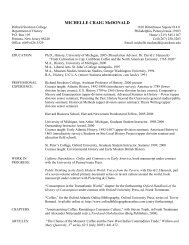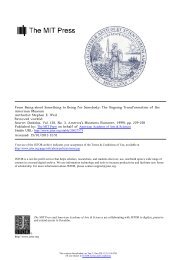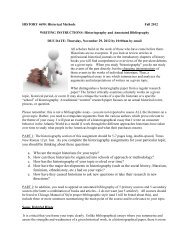Domesticating Barbie - Richard Stockton College Word Press ...
Domesticating Barbie - Richard Stockton College Word Press ...
Domesticating Barbie - Richard Stockton College Word Press ...
Create successful ePaper yourself
Turn your PDF publications into a flip-book with our unique Google optimized e-Paper software.
<strong>Domesticating</strong> <strong>Barbie</strong> 235<br />
"Sweater Girl" was 1 of only 3 of <strong>Barbie</strong>'s original 22 outfits which placed<br />
<strong>Barbie</strong> in any domestic labor. The sweater ensemble's knitting kit suggested that<br />
she could knit, but this outfit can be interpreted in several, not necessarily exclu<br />
sive ways. First, knitting is a traditional household production skill, so it could<br />
imply <strong>Barbie</strong>'s conventional domesticity. Second, <strong>Barbie</strong>'s craft could somewhat<br />
conversely be seen as creative ingenuity, an imagination in tune with her interest in<br />
fashion and aspiration to a world outside the home and family. Third, the knitting<br />
accessories may simply have been a<br />
smirking cover-up of <strong>Barbie</strong>'s "real" iden<br />
tity as Hollywood pinup, a sexual siren concealed in the guise<br />
seamstress.<br />
of domesticated<br />
What Mattel intended the outfit to signify is almost irrelevant, because<br />
"Sweater Girl" and other outfits were sufficiently ambiguous to evoke somewhat<br />
contradictory symbolic associations. The other 2 "domestic" outfits in the original<br />
line of 22 are equally ambiguous. "Suburban Shopper," for instance, came with a<br />
small tote bag of fruit suggesting a trip to the market, but the tote was somewhat<br />
incongruous with the accompanying crisp sundress, straw hat, and pearl necklace.<br />
The fruit in the tote bag may have been whimsical decoration, a decorative ac<br />
cessory which was carried along on a shopping excursion to a fashion designer's<br />
showroom rather than the grocery store. This seemingly uncommon mix of ele<br />
ments in a single outfit would provide a somewhat unusual model for an adult,<br />
but for a child playing with "Suburban Shopper" this was likely not such an in<br />
congruity. For children, some of the most glaring disparities between "real life"<br />
and <strong>Barbie</strong> were likely unimportant because play itself assumes a fundamentally<br />
imaginative dimension and a loose relationship with "reality." For parents, <strong>Barbie</strong><br />
play may be considered a process of learning and reproducing dominant social<br />
values through role simulation, and Ernest Dichter counseled Mattel to market the<br />
doll to parents as such a<br />
role-play tool. For children, on the other hand, play is not<br />
simply instrumental role mimicry; instead, it embraces imaginative make-believe<br />
which can<br />
suspend<br />
or redefine predominant social values and practice (on play,<br />
see Dant, 1998, pp. 79-84).<br />
The remaining domestic outfit, "<strong>Barbie</strong>-Q," placed <strong>Barbie</strong> in an apron whose<br />
pockets were filled with barbecue utensils and a potholder. Susan Willis (1991,<br />
p. 98) reduces this outfit to evidence of <strong>Barbie</strong>'s thorough and historically static<br />
domesticity, but <strong>Barbie</strong>'s chef hat and the name of the outfit imply that the context<br />
is entertaining, not cooking as a<br />
daily labor. Indeed, barbecuing itself is so heavily<br />
contextualized as a male activity that <strong>Barbie</strong> may actually have usurped male<br />
privilege by seizing control of the grill.<br />
The attraction of outfits like "<strong>Barbie</strong>-Q" is that they paradoxically implied a<br />
predictable social stability as well as radically novel possibilities (cf. Muggleton,<br />
1997, p. 186). "<strong>Barbie</strong>-Q" harbors elements of a rational and calculated vision of<br />
traditional domesticity, but it also concedes other social roles. This amalgam of<br />
contradictory symbolisms is typical of the most compelling toys: their idealized<br />
symbolism may be uniform, predictable,<br />
and conservative, but to maintain their<br />
This content downloaded on Tue, 15 Jan 2013 10:45:42 AM<br />
All use subject to JSTOR Terms and Conditions



